Updated on January 8, 2024

What are the different French dance styles?

Looking at all the kinds of dance styles that have spread throughout France and beyond over the centuries, you’d be forgiven for thinking the country has danced its way through its history. There are many musical genres and choreographies at play. Some reflect long-lasting traditions, and others break away from them. But all contribute to the varied cultural landscape and social daily life in France. And with that being said, let’s now look at some of the most famous and emblematic French dances.
While most traditional French dances may not be particularly well-known outside the country, two of them have managed to cross borders and gained worldwide fame and immediately bring an idea of a certain French lifestyle.
It’s difficult to think of a dance style more emblematic and more closely associated to a venue and a specific time of history. The French cancan stole the show at the end of the 20th century, when such renowned French painters as Henri de Toulouse Lautrec painted posters for the Moulin Rouge and its most famous dancers.
Of course, the valse musette is nowhere near as famous as the French cancan. Yet, you only need to know it is danced to the sound of the accordion to understand just how iconic a French dance it is. Born in the 1880s around the time of the Belle Époque, you might still see it danced nowadays in village halls on the 14th of July, for Bastille Day: It is just as traditional as watching the military parade on the Champs-Élysées or listening to such anthems as “La Marseillaise” and “Le chant des partisans”.
It is simply impossible to list all the folkloric dances that may exist throughout France in one blog. Thankfully, some are more famous than others, so we narrowed it down to three well-known ones.
This open-chain community dance has been danced in France for centuries, most notably in the south-east region of Provence. In fact, rumor has it the farandole is the oldest traditional dance in the country. It is also probably one of the easiest, which is why even children enjoy dancing a simplified version of it in the school playground.
As you may guess from the name of this French dance, the bourrée auvergnate is originally from the central region of Auvergne. Still danced on special occasions nowadays, it first appeared and gained popularity in the 16th century, to the point of spreading to other countries in Western Europe, including Great Britain.
While maybe a little less famous than the first two folkloric dances on our list, the maraîchine is still worth mentioning. Traditionally performed in a line or a circle, this type of dance comes from two regions in the north-west of France, namely Poitou and Bretagne (or Britanny in English). In fact, the latter is well-known for its many dances of celtic inspiration.
History and traditions are all very well, but what about more modern trends? In the last century, newer dance styles have appeared at balls and parties across France.
Another dance commonly seen in the local dance balls across France, the java is characterized by its quick, small steps. The dance became popular in the 1920s and 1930s among working-class people, who preferred it over the waltz, which they judged too bourgeois.
Yes, technically, the Madison is an American dance and not a French one. However, it quickly spread in France and became highly popular in the 1960s. The decade has come to symbolize a time of change in the country. A new generation keen to break away from certain traditions was quickly emerging, as reflected in the new music and dance styles of the time. Eventually, this led to the events of May 1968.
All the way from the French West Indies, more specifically the islands of Guadeloupe and Martinique, as well as Haiti, Dominica and Saint Lucia, the zouk relies on a savvy blend of Caribbean, African and North African musical styles. If you wonder what the zouk dance is, you first need to know the word “zouk” refers to nightlong dance parties in the local Creole language. So it’s hardly any surprise it is characterized by its fast tempo and its sensual moves.
These eight dances may only be a small sample, but they do show the variety of styles on the French dance scene, from folkloric traditions to moves from faraway lands. You’re bound to find one to your taste, whether you fancy taking part to a bal musette for Bastille Day or get dancing all night long.